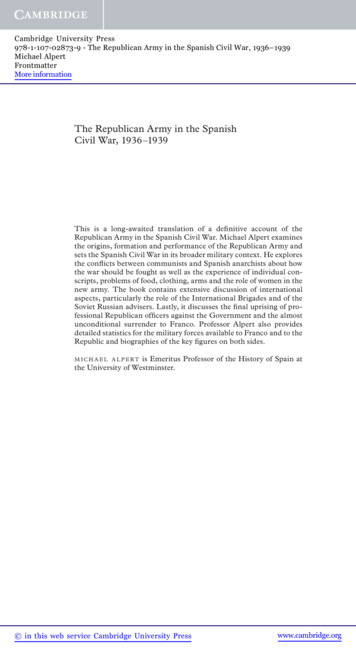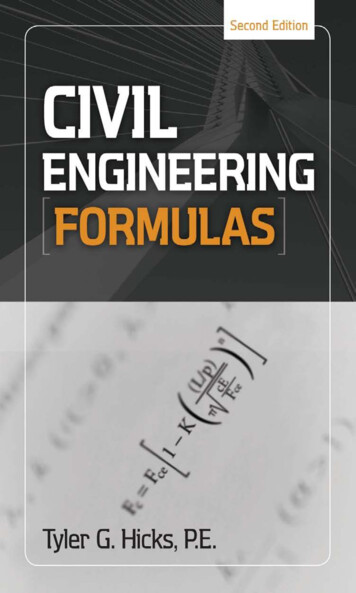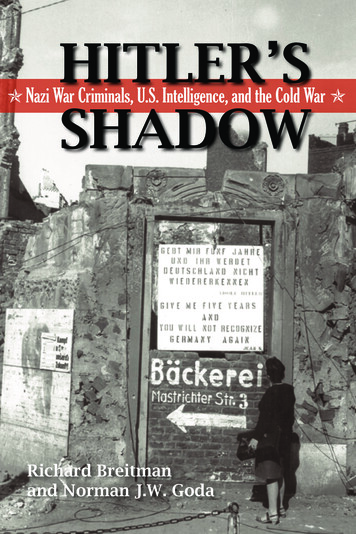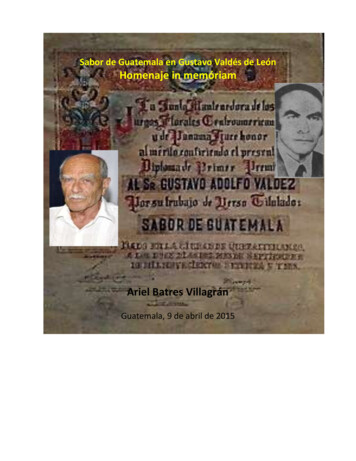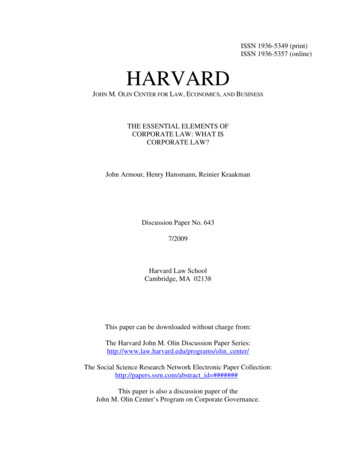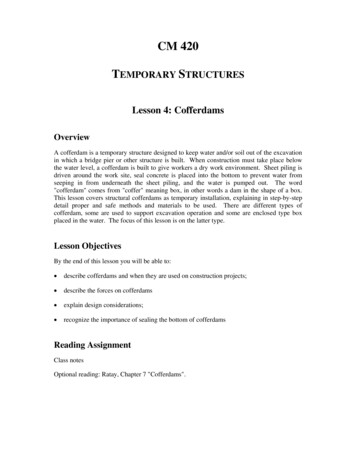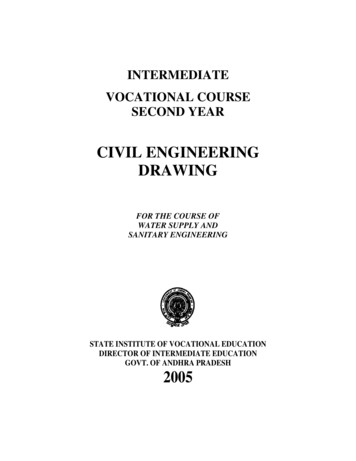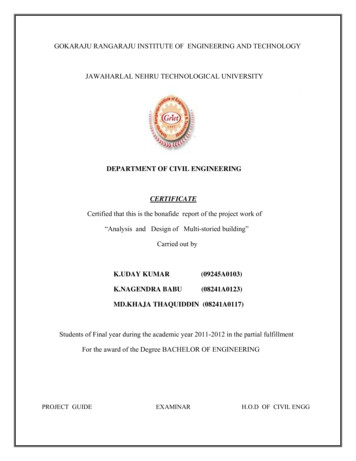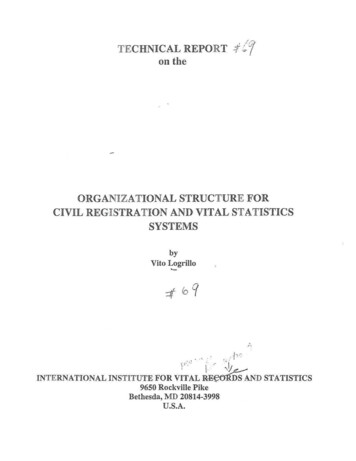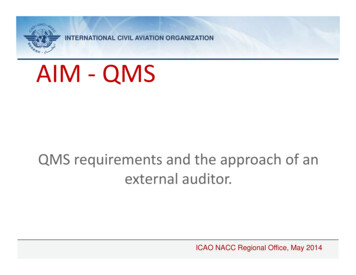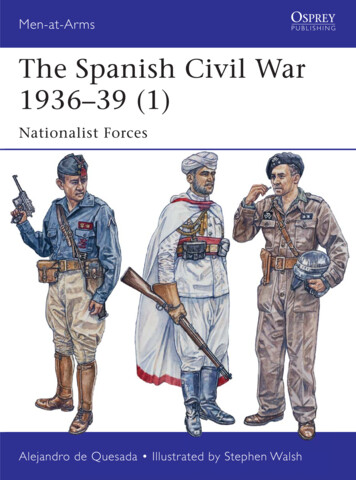
Transcription
Men-at-ArmsThe Spanish Civil War1936–39 (1)NationalistNationalli t ForceslistF"MFKBOESP EF 2VFTBEB r *MMVTUSBUFE CZ 4UFQIFO 8BMTI"MFKBOESP EEF 2VFTBEB r *MMVTUSBUFE CZ 4UFQIFO 8BMTIEF 2VFTBEB r *MMVTUSBU E C 4U I 8 M I
Men-at-Arms . 495The Spanish Civil War1936–39 (1)Nationalist ForcesAlejandro de Quesada . Illustrated by Stephen WalshSeries editor Mar tin Windrow
THE SPANISH CIVIL WAR 1936–39(1) NATIONALIST FORCESINTRODUCTIONTGeneral Francisco Franco yBahamonde (see Plate A1). Aformer officer of Regulares inMorocco, in 1920 Franco was theoriginal second-in-command ofthe Spanish Foreign Legion underLtCol José Millán Astray, andduring the Rif War (1921–26) hispersonal courage, leadership andapplication to duty saw him risefrom major to brigadier-general.Although he was the chief of staffunder the 1933 CEDA-backedgovernment, ‘Pacquito’ was notthe original director of the UME’smilitary rebellion in July 1936;however, he immediately seizedthe opportunity presented by hissuccessful takeover of theMorocco garrison, the mostformidable command in theSpanish Army. That October hebecame supreme commander ofthe disparate Nationalist forces,and by April 1937 he had weldedthe political Right into a unifiedmovement under his own control.After his victory in the Civil Warhe became the longest-rulingdictator in modern Europeanhistory. (AdeQ Historical Archives)he Spanish Civil War was the curtain-raiser to World War II, andthe major focus of international attention in Europe in the late1930s. It was fought between the rebel Nationalist army led by GenFrancisco Franco (‘right wing’, and aided by Nazi Germany, Fascist Italy,and some foreign volunteers from conservative countries), and the armyof the Spanish Republican government (‘left wing’, and aided by theCommunist Soviet Union and many volunteers from liberal democracies).The war involved the most modern weapons then available –particularly aircraft, both operating in direct support of ground forcesand bombing enemy-held towns. Like all civil wars, it was foughtferociously by both sidesandcausedimmensesuffering to civilians. Froma Spanish population ofabout 24 million, at least500,000 people died in thisbitter war of attrition andin the repression thatfollowed it. When theNationalists secured victorythey installed a dictatorshipthat lasted from April 1939until November 1975 –the last such regime inWestern Europe.The Nationalist forceswere varied in origin. Theirspearhead was provided bythe colonial army broughtover from Spanish Morocco,and, apart from sympathizerswithin the pre-war regulararmy who joined the 1936rebellion, troops raised inSpain thereafter by voluntaryenlistment and conscriptionreflected a number of distinctclass, regional, political andreligious traditions. It isincorrect to characterizethem,withsimplistic3
Colonel José Moscardó e Ituartebecame famous for his commandin summer 1936 of theNationalist defenders of thebesieged Alcázar fortress inRepublican-held Toledo, refusingto surrender even to save hisown son from execution. Francoordered the ‘Madrid Column’ ledby Col Yagüe to divert from theirobjective to relieve the Alcázargarrison, for reasons of publicopinion; when Yagüe reportedlyobjected he was replaced ‘forhealth reasons’ with Gen Varela.(AdeQHA)hindsight, as conscious agents of international fascism: for the hugemajority the war was an entirely local cause, and very many saw it asa Catholic crusade.Osprey has published separate titles on a number of specific subjectsrelating to the Spanish Civil War (see listing on inside back cover).For reasons of space, this volume is limited to an overview of thecomponents that made up the Nationalist forces, as a primer for thosewishing to delve more deeply into the subject.CHRONOLOGY1936:February–July17–19 July27 July6 August14 August16 August13 September24 September1 October7 October30 October23 NovemberDecember1937:6–27 February4Popular Front victory in general election is followedby widespread civil unrest and violence.Military coups are attempted in Morocco and all overSpain, but are defeated in Madrid, Barcelonaand other cities, thus making civil war inevitable.At request of Gen Franco, commanding the Armyof Africa, German and Italian aircraft join airlift(begun on 20th) of Nationalist troops from Moroccoto southern Spain.First German combat aircraft and personnel arrivein Spain.Nationalist troops from Africa under LtCol Yagüecapture Badajoz.Republican landing in Majorca, Balearic Islands,in unsuccessful attempt to put down rebellionby garrison; Italian aircraft support Nationalistcounterattacks.Nationalists take San Sebastian, having securedmost of northern and western Spain for the rebels.Nationalists divert troops south-eastwards frommarch on Madrid to relieve besieged garrison ofthe Alcázar in Toledo (accomplished on 27th).Gen Franco named as Generalísimo y Jefe de Estado –Nationalist military commander-in-chief and headof government.First German armoured troops arrive in Spain.Official creation of German ‘Condor Legion’.After hard fighting in outskirts against Republicanswith Soviet armour and International Brigadesupport, Nationalists abandon attempt to takeMadrid.Nationalist offensives north-west of Madrid, and insouth from to expand territory in Andalucia. First3,000 Italian ground troops land at Cádiz (23rd).Battle of the Jarama river: Nationalist offensivesouth-east of Madrid, with mostly Africa Army troops,ends in stalemate. In Andalucia, Nationalists and
MarchAprilMay19 June6–24 July24 August26 August6 SeptemberItalians take Málaga (8th). Official creation ofItalian Corpo Truppe Volontarie (17th).Republicans repel Nationalist/Italian advance onGuadalajara, north-east of Madrid.Franco unites Nationalists, neo-fascist Falangistsand monarchist Carlists into a single politicalMovimiento Nacional and army under his control.Nationalist advances on north-coast ports ofSantander and Bilbao.Bilbao surrenders to Nationalists.Republican offensive at Brunete, west of Madrid;advance halted and driven back by Nationalistreinforcements withdrawn from northern front.Republican offensive north-east of Madrid opensat Belchite, south of Saragossa.In Asturias, Nationalists take Santander.Republicans take Belchite, but advance endsin stalemate.Map showing basic outlinesof Republican and Nationalistterritories in summer 1936and summer 1938. Note thatspelling of some placenamesis anglicized. (Map byJohn Richards)5
21 OctoberDecember1938:7 January22 February9 MarchAprilJuly25 JulyA typical portrait of a Nationalistfield officer posing in summereveryday uniform of a khaki shirtand olive trousers; note thetypically wide cut of the collar.On his left breast the three8-point gold stars of colonel aredisplayed on a ‘galeta’ of redInfantry branch-of-service colour.This officer is Heli Rolando deTella y Cantos, who began theCivil War as a major and ended itas a brigadier-general; hisdecorations included a MilitaryMerit Medal awarded in 1923 forservice in Morocco, and theprestigious San Fernando Cross.In September 1936 Tella led acolumn (I Tabor/Regulares deTetuán, I Bandera/Tercio, plus aGuardia Civil company) toMadrid. Wounded in the winterfighting for the University City,he was promoted general in April1938, and held commands duringthe Ebro and Cataloniacampaigns. (AdeQHA)66 August–16 November23 December1939:JanuaryFebruary28 March1 AprilOn Asturias front, Nationalists take last Republicanstronghold of Gijón.Republicans launch offensive against Nationalist salientat Teruel, east of Madrid (14th). Nationalist counteroffensive ends in stalemate in harsh winter conditions.Republican troops capture remaining Nationalistpositions in Teruel, but are themselves encircled.Nationalists retake Teruel.In Aragón, Franco launches major offensive eastwardstowards Mediterranean coast, to cut off Cataloniafrom Valencia and southern Republican territory.Nationalists take Lerida (3rd); reach Mediterranean atVinaroz (15th), and fan out over 30 miles of coastline.Nationalist drive on Valencia fails at cost ofc.17,500 casualties.Republican Army of the Ebro, with c.120,000 menin Catalonia, launches offensive southwards acrossEbro river to cut Nationalist corridor and link upwith Valencia. Some units advance 25 miles, but allare soon halted and forced to dig in.In prolonged, costly fighting (41,400 Nationalistcasualties, to 70,000 Republican), Franco’s reinforcedcorps eventually force the Republicans back acrossthe Ebro. Franco can now concentrate on theRepublican capitals: Barcelona and Madrid.Franco launches Catalonia offensive on the Rio Segre.Nationalists capture Tarragona (7th), and enterundefended Barcelona (27th).Republican leaders flee to France (6th); Nationalistsreach French frontier (9th). Internecine Republicanfaction-fighting in Madrid (23 February–13 March).Britain and France recognize Franco’s government(27th).Nationalist troops enter Madrid.Nationalist troops enter Valencia; Franco declaresend of war.BACKGROUND TO REBELLIONThe Second Spanish Republic was proclaimed on 14 April 1931.King Alfonso XIII had forced the military dictator Gen Miguel Primo deRivera to resign after seven years in power, but when nationwidemunicipal elections revealed the strength of the parties of the Left inthe cities the king chose to flee the country. The mass electorate’sexpectations for social reforms, land redistribution and regionaldevolution went far beyond the realistic abilities of the new Republicangovernment, which inherited a bankrupt and politically polarized state
without functioning democratic institutions. In pursuit ofmany social and regional agendas, different interest groupsformed a political spectrum stretching from the extremeRight to the extreme Left and a powerful Anarchistmovement, and in an atmosphere of deep uncertaintythese factional hatreds could spark murderous violence.In January 1932 a number of Army officers led by GenJosé Sanjurjo tried to overthrow the government of PrimeMinister Manuel Azaña, but the bulk of the armed forcesremained obedient. However, a new political partywas formed: the Confederación Española de DerechasAutónomas (Spanish Confederation of AutonomousRight-wing Groups, CEDA). This presented itself as theprotector of religion, family, and property rights againstthe radical ambitions of the Left. In 1933 the CEDA won ageneral election, and put a brake on popular reforms.There were other forces further to the Right, though withconflicting ideologies. The ultra-traditionalist, Catholic,monarchist Carlists were a century-old movement thatenjoyed a strong revival, particularly but not exclusively inthe province of Navarre. In October 1933 José AntonioPrimo de Rivera, son of the former dictator, founded theFalange Española movement; with a programme similar to that of theItalian Fascists, this party was basically anti-clerical and anti-monarchist.At the other political extreme, in October 1934 the ‘Asturias Revolution’saw the murder by rabidly anti-clerical Leftists of 37 priests, monksand seminarians and the destruction of 58 churches – actions that manyconservatives interpreted as the beginning of a widespread ‘Red terror’.In elections of February 1936 the CEDA-backed government was narrowlydefeated by a Popular Front of Leftist parties, within which moderateRepublicans had responsibility but little control. Left-wing and Anarchisttrade unions staged widespread strikes, and in Catalonia the Marxist andAnarchist groups competed for power. Poverty-stricken rural peasantsseized land from wealthy estate-owners, and many churches were burneddown with impunity. The Falange was banned and its leader José AntonioPrimo de Rivera was arrested (still in prison at the time of the July rebellion,he was nevertheless charged with conspiracy and insurrection, and executedon 20 November). In the ensuing atmosphere of crisis, on 13 July a leadingright-wing politician, José Calvo Sotelo, was assassinated by governmentAssault Guards. Both Carlists and Falangists then put their hopes andresources behind a conspiracy by the Unión Militar Española (SpanishMilitary Union, UME), founded in 1933, to instal a military dictatorship.On 17–18 July senior officers led mutinies in all the main Spanishgarrison towns, with varying degrees of success. Many were arrestedand shot, but in the north Gen Emilio Mola raised Navarre, to befollowed by most of Aragón, Old Castile, Alava, León and Galicia, andin the far south Gen Queipo de Llano led garrisons in western Andaluciain revolt. General Franco, who had been sidelined by an appointment ascommander in the Canary Islands, quickly flew to Spanish Morocco.At Tetuán on 19 July he overthrew the civil authorities of the protectorate,and after a number of judicious executions the great majority of theofficers and troops rallied to him.A German war correspondentinterviewing two Spanish soldierswearing the regulation dressof ‘gorrillo’, ‘guerrera’ and‘granaderos’. From the outset,Nazi Germany and Fascist Italywere determined to support theNationalist rising in Spain. TheCatholic aspect of the strugglewas irrelevant to Berlin andRome, but they shared someideological beliefs with the UMEleadership, being united intheir hostility to Communism –especially after the USSRintervened heavily in supportof the Republic. For all threeinterventionist powers Spainprovided testing-grounds fortheir personnel, weaponry andtactics, particularly in thecontexts of air and armouredwarfare. In 1939 a total of nearly18,000 German militarypersonnel of all three serviceswould be awarded a new Germandecoration, the Spanish Crosswith Swords, for active serviceduring the Civil War. (AdeQHA)7
Brown-uniformed membersof the German Condor Legionphotographed fraternizing withthe family of a city policeman ofthe Cuerpo de Seguridad yAsalto. The child is dressed inthe uniform of the Falange party.About one-third of the urbanpolice sided with the Nationalistsin 1936. (AdeQHA)The generals’ July coup d’état provoked furious r
he Spanish Civil War was the curtain-raiser to World War II, and the major focus of international attention in Europe in the late 1930s. It was fought between the rebel Nationalist army led by Gen Francisco Franco (‘right wing’, and aided by Nazi Germany, Fascist Italy, and some foreign volunteers from conservative countries), and the army of the Spanish Republican government (‘left wing .
